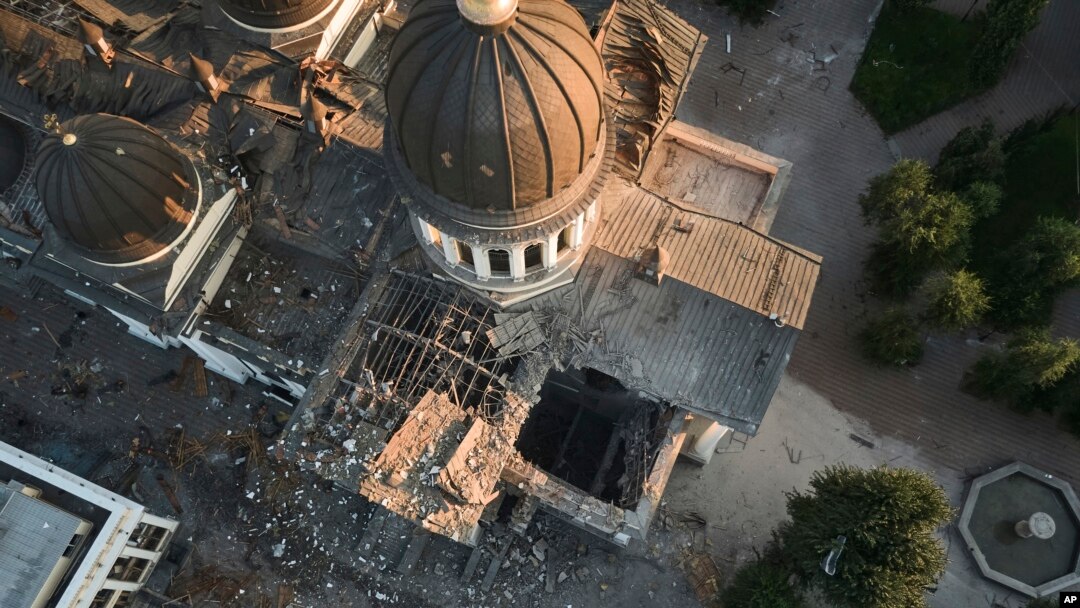At least one person was killed and 22 wounded, including four children, in fresh Russian missile strikes on the Ukrainian port city of Odesa, Ukrainian officials said on July 23.
An Orthodox cathedral was also seriously damaged in the overnight Russian military attack, Oleh Kiper, governor of southern Ukraine's Odesa region, said on the Telegram messaging app.
“Odesa: another night attack of the monsters,” wrote Kiper.
Some reports said that a second person had died from the Odesa strike, but that could not immediately be confirmed.
Russia’s military has launched military strikes on Odesa and other Ukrainian food export facilities over the past week after the Kremlin withdrew from a UN-brokered sea corridor agreement that allowed for the safe shipment of Ukrainian grain. Kyiv has accused Moscow of targeting grain supplies and infrastructure vital to the deal.
WATCH: Locals rushed to the Transfiguration Cathedral in the Ukrainian port city of Odesa to clear it from rubble after an overnight Russian missile attack on July 23. Odesa's largest Orthodox church was consecrated in 1809, destroyed by the Soviet authorities in 1939, and rebuilt in 2003. The city center is on the UNESCO World Heritage List.
Your browser doesn’t support HTML5
Volunteers Clean Up Damaged Odesa Cathedral After Russian Attack
Foreign Minister Dmytro Kuleba said Kyiv would submit the attack on the Orthodox cathedral as evidence to the United Nations of Russia’s “systematic” destruction of religious sites in Ukraine during its invasion.
"The latest case is today's strike on the Transfiguration Cathedral in Odesa. We will raise this issue at the next meeting of the UN Security Council on Ukraine to make it clear: Russia is the only threat to Ukrainian Orthodoxy," Kuleba wrote on Twitter.
Ukrainian President Volodymyr Zelenskiy said in a Twitter post after the Russian strike on Odesa that “missiles against peaceful cities, against residential buildings, a cathedral.... There can be no excuse for Russian evil. As always, this evil will lose. And there will definitely be a retaliation to Russian terrorists for Odesa. They will feel this retaliation.”
Zelenskiy also urged Ukraine’s Western allies to speed up delivery of air-defense systems to help it defend itself against Russian missile “terror.”
“Thanks to the help of partners and air-defense systems provided to Ukraine, our sky defenders have saved thousands of lives. But for our entire territory, for all our cities and communities, we need more air-defense systems. The world should not get used to Russian terror -- it is necessary to defeat terror. And it is possible," Zelenskiy wrote.
Odesa's military administration said that the cathedral of the Moscow-linked Ukrainian Orthodox Church (UOC) was severely damaged.
Live Briefing: Russia's Invasion Of Ukraine
RFE/RL's Ukraine Live Briefing gives you the latest developments on Russia's invasion, Western military aid, the plight of civilians, and territorial control maps. For all of RFE/RL's coverage of the war, click here.
"The Kasperovska icon of the Mother of God, who is the patroness of Odesa, was retrieved from under the rubble," the administration said on its Telegram channel.
Andriy Palchuk, the cathedral's archdeacon, told Reuters that the missile strike had started a fire that only affected one corner of the cathedral containing nonhistoric religious artifacts for purchase by worshippers.
"When the right altar chapel -- one of the most sacred parts of the cathedral -- was hit, a missile piece flew through the whole cathedral and hit the area where we display icons, candles, and books for purchase," he said.
The Russian Defense Ministry reported strikes on targets in the area but denied it had struck the cathedral and claimed the building had probably been hit by a Ukrainian anti-aircraft missile.
The Spaso-Preobrazhenskiy Cathedral, or the Transfiguration Cathedral, is Odesa's largest Orthodox church and was consecrated in 1809. It was destroyed by the Soviet authorities in 1939 but rebuilt in 2003.
In video posted to social media, Mayor Hennadiy Trukhanov is seen walking amidst the rubble inside the church.
Another video clip showed a man walking inside the cathedral repeating, "The church is no longer.… Lord, have mercy.”
SEE ALSO: Wagner Troops In Belarus 'Want To Go West' Into Poland, Lukashenka Quips During Meeting With PutinOther photos and videos showed parts of the building destroyed and rubble inside with several icons lined up on the ground.
Ukraine's Southern Operational Command said Odesa was targeted with at least five types of missiles, including high-precision Onyx missiles, sea-to-shore Kalibr cruise missiles, and Iskander ballistic missiles.
The city's military administration said that air-defense systems had destroyed a "significant part" of them.
Andriy Yermak, Zelenskiy's chief of staff, repeated calls for more missiles and defense systems.
"The enemy must be deprived of the ability to hit civilians and infrastructure. More missile defense systems, as well as ATACMS -- this will help Ukraine," Yermak wrote on Telegram, referring to the long-range tactical missiles that Kyiv wants Washington to supply.
Odesa has been bombed several times since the start of the invasion, and in January the United Nations cultural agency UNESCO designated the historic center of the city as a World Heritage in Danger site.
On July 23, UNESCO issued a statement “strongly” condemning Russia’s “repeated attacks” against cultural and heritage sites.
“UNESCO is deeply dismayed and condemns in the strongest terms the brazen attack carried out by the Russian forces, which hit several cultural sites in the city center of Odesa, home to the World Heritage property,” it said.
It said the latest attack, in addition to taking human life, “damaged a number of significant cultural sites, including the Transfiguration Cathedral, the first and foremost Orthodox church in Odesa founded in 1794."


